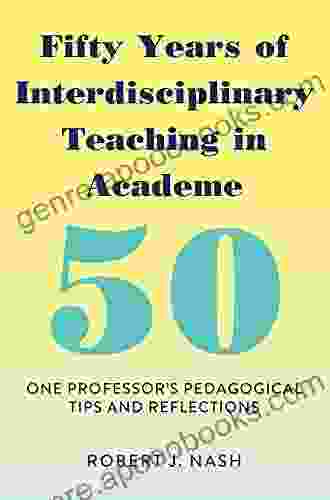Fifty Years of Interdisciplinary Teaching in Academe: A Journey of Innovation and Collaboration

: The Genesis of Interdisciplinary Teaching
In the ever-evolving landscape of higher education, interdisciplinary teaching has emerged as a transformative pedagogical approach, bridging the boundaries between traditional academic disciplines and fostering a holistic understanding of complex issues. This article embarks on a journey through five decades of its groundbreaking history, exploring the origins, challenges, and enduring legacy of interdisciplinary teaching in academe.
The seeds of interdisciplinary teaching were sown in the tumultuous 1960s, amidst a period of social and intellectual upheaval. Students and faculty alike questioned the rigid disciplinary silos that dominated higher education, seeking more relevant and engaging learning experiences. This yearning for cross-disciplinary exploration gave birth to the first interdisciplinary programs, primarily in the social sciences and humanities.
5 out of 5
| Language | : | English |
| File size | : | 532 KB |
| Text-to-Speech | : | Enabled |
| Screen Reader | : | Supported |
| Enhanced typesetting | : | Enabled |
| Word Wise | : | Enabled |
| Print length | : | 231 pages |
The Early Years: Experimentation and Innovation
The early years of interdisciplinary teaching were characterized by experimentation and innovation. Educators sought to break down disciplinary barriers and create new academic pathways. They developed cutting-edge courses that combined perspectives from multiple disciplines, challenging students to think critically and creatively about complex problems. Interdisciplinary research also gained momentum, as scholars recognized the need to collaborate across disciplines to address pressing societal issues.
However, this pioneering era was not without its challenges. Resistance from traditionalists who clung to disciplinary boundaries hindered the widespread adoption of interdisciplinary teaching. Funding for interdisciplinary programs was often scarce, and educators faced skepticism from administrators and accreditation bodies. Despite these obstacles, interdisciplinary teaching continued to gain traction, its proponents advocating for its transformative potential.
The Expansion and Institutionalization of Interdisciplinary Teaching
By the 1980s and 1990s, interdisciplinary teaching had gained wider acceptance and institutionalization. An increasing number of colleges and universities established interdisciplinary programs, centers, and institutes. Faculty development initiatives emerged to support educators in developing interdisciplinary curricula and teaching methods. Interdisciplinary research flourished, leading to groundbreaking discoveries and innovative applications across a diverse range of fields.
As interdisciplinary teaching became more established, its benefits became increasingly evident. Students who engaged in interdisciplinary learning demonstrated stronger critical thinking skills, problem-solving abilities, and creativity. They were better equipped to tackle complex issues that defied traditional disciplinary boundaries. Interdisciplinary research also had a transformative impact, fostering collaboration and innovation, and contributing to the development of new knowledge and solutions to real-world problems.
The Challenges and Controversies of Interdisciplinary Teaching
Despite its growing recognition and successes, interdisciplinary teaching continued to face challenges. Some critics argued that it diluted academic rigor and undermined disciplinary expertise. Others expressed concerns about the lack of standardized assessment methods and the potential for interdisciplinary programs to become overly fragmented and lacking in coherence.
These controversies highlighted the ongoing tensions between disciplinary specialization and interdisciplinary collaboration. However, they also sparked important debates about the purpose and value of higher education in the 21st century. As society becomes increasingly interconnected and complex, the need for graduates who can think and work across disciplinary boundaries becomes paramount.
The Future of Interdisciplinary Teaching
Today, interdisciplinary teaching stands at a crossroads. Its proponents continue to advocate for its transformative potential, emphasizing its ability to prepare students for the challenges of an interconnected world. However, the future of interdisciplinary teaching is uncertain. Funding remains a challenge, and the pressure to demonstrate quantifiable outcomes may hinder its continued growth.
Yet, despite these challenges, there is reason to believe that interdisciplinary teaching will continue to evolve and flourish. The increasing complexity of societal problems and the rise of interdisciplinary research demand graduates who are equipped with the skills and perspectives to navigate these complex challenges. Interdisciplinary teaching provides a unique and valuable pathway to培养 such graduates, fostering a generation of critical thinkers, problem-solvers, and innovators who can shape the future.
: A Legacy of Innovation and Collaboration
Fifty years of interdisciplinary teaching in academe have witnessed remarkable innovation and collaboration, transforming higher education and preparing students to address the complex challenges of an interconnected world. From its humble beginnings in the 1960s to its institutionalization in the present day, interdisciplinary teaching has proven its resilience and enduring value.
As we look to the future, it is essential to continue to support and promote interdisciplinary teaching. By embracing collaboration, innovation, and a commitment to student learning, we can ensure that this transformative pedagogical approach continues to flourish and equip our graduates with the skills and perspectives they need to thrive in the 21st century and beyond.
5 out of 5
| Language | : | English |
| File size | : | 532 KB |
| Text-to-Speech | : | Enabled |
| Screen Reader | : | Supported |
| Enhanced typesetting | : | Enabled |
| Word Wise | : | Enabled |
| Print length | : | 231 pages |
Do you want to contribute by writing guest posts on this blog?
Please contact us and send us a resume of previous articles that you have written.
 Book
Book Novel
Novel Page
Page Chapter
Chapter Text
Text Story
Story Genre
Genre Reader
Reader Library
Library Paperback
Paperback E-book
E-book Magazine
Magazine Newspaper
Newspaper Paragraph
Paragraph Sentence
Sentence Bookmark
Bookmark Shelf
Shelf Glossary
Glossary Bibliography
Bibliography Foreword
Foreword Preface
Preface Synopsis
Synopsis Annotation
Annotation Footnote
Footnote Manuscript
Manuscript Scroll
Scroll Codex
Codex Tome
Tome Bestseller
Bestseller Classics
Classics Library card
Library card Narrative
Narrative Biography
Biography Autobiography
Autobiography Memoir
Memoir Reference
Reference Encyclopedia
Encyclopedia West End Producer
West End Producer Sophia Marie
Sophia Marie Pinoy Stitch
Pinoy Stitch Lee Zimmerman
Lee Zimmerman M I Seka
M I Seka Sheila J Nayar
Sheila J Nayar Mary Ann Sternberg
Mary Ann Sternberg Richard Baker
Richard Baker Renee Olivier
Renee Olivier Peter H Schuck
Peter H Schuck William F Felice
William F Felice Mark Vernon
Mark Vernon Peter L Bergen
Peter L Bergen Lawrence W Levine
Lawrence W Levine Matthew Ward
Matthew Ward Sam Minot
Sam Minot V Pathak
V Pathak Naleighna Kai
Naleighna Kai Yasmin Henkesh
Yasmin Henkesh Harvey Kurtzman
Harvey Kurtzman
Light bulbAdvertise smarter! Our strategic ad space ensures maximum exposure. Reserve your spot today!

 Patrick RothfussThe Evil Lord of an Intergalactic Empire Light Novel Vol. 1: Unleashing a...
Patrick RothfussThe Evil Lord of an Intergalactic Empire Light Novel Vol. 1: Unleashing a... Grayson BellFollow ·15.5k
Grayson BellFollow ·15.5k Jorge Luis BorgesFollow ·7.5k
Jorge Luis BorgesFollow ·7.5k Braden WardFollow ·18.1k
Braden WardFollow ·18.1k Adam HayesFollow ·16.3k
Adam HayesFollow ·16.3k William GoldingFollow ·13.4k
William GoldingFollow ·13.4k Deion SimmonsFollow ·6.6k
Deion SimmonsFollow ·6.6k Stuart BlairFollow ·2.9k
Stuart BlairFollow ·2.9k Rod WardFollow ·5.5k
Rod WardFollow ·5.5k

 Finn Cox
Finn CoxCarmen Suite For Flute Quartet (G Alto Flute) ( Carmen...
Experience the Magic of...

 Andy Cole
Andy ColeUncover Hidden Truths: A Comprehensive Guide to Detecting...
: The Silent...

 Ken Simmons
Ken SimmonsUnleash Your Potential: Transform Frustration and...
Are you tired of feeling...

 Rick Nelson
Rick NelsonHard To Kill: A Gripping Thriller That Will Keep You on...
Tom Rollins is a...

 Ivan Turner
Ivan TurnerUnleash the Power of Your Breath: Discover Breath...
In the tapestry of life, where stress and...
5 out of 5
| Language | : | English |
| File size | : | 532 KB |
| Text-to-Speech | : | Enabled |
| Screen Reader | : | Supported |
| Enhanced typesetting | : | Enabled |
| Word Wise | : | Enabled |
| Print length | : | 231 pages |












